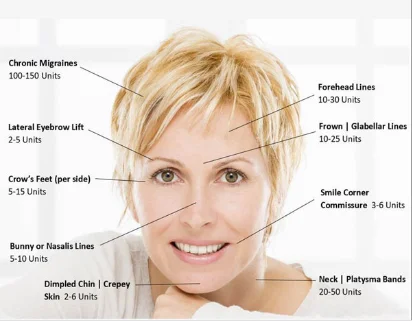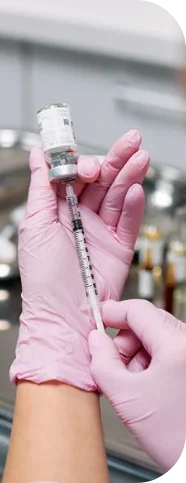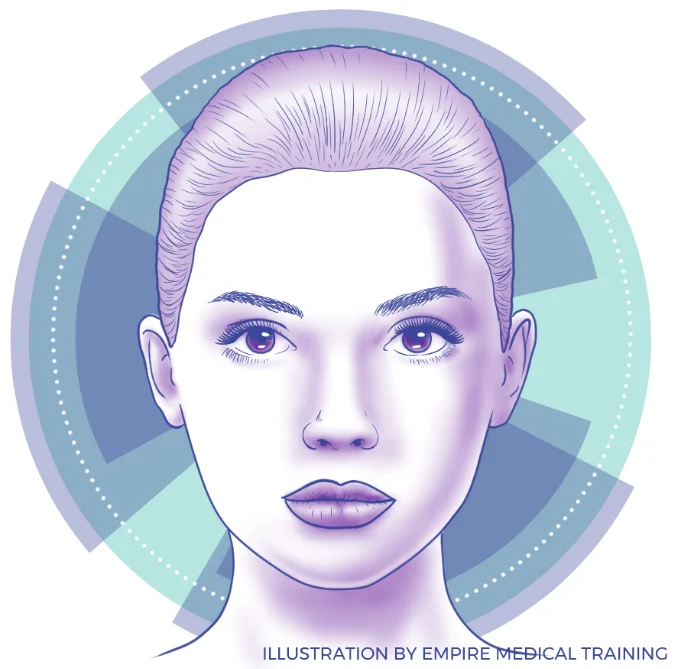Botox® Face Chart
Neurotoxins | March 15, 2021

Botox® Face Chart
Entry made by
Empire Medical Training
Botox®, the world’s most common non-surgical cosmetic treatment, offers a seemingly endless array of cosmetic possibilities, many of which concern the face and forehead.
First-time patients and clinicians alike should
be familiar with the most common Botox injection sites and treatment zones.
The best way to gain that familiarity
is with a Botox face chart like the one shown and described here.
Botox Face Chart: Where to Inject Botox
These are the most common cosmetic issues that facial Botox treatments can temporarily correct:
- Forehead (forehead lines)
- Eyebrows (lateral eyebrow lift)
- Frown lines (glabellar lines or ‘11’ lines)
- Crows’ feet
-
Bunny lines
-
Gummy smile
- Lip lines (smokers’ lines)
-
Marionette lines (sad smile)
-
Dimpled chin
- Platysmal bands

Each issue corresponds to a specific area or zone of the face:
-
Forehead lines: Forehead lines may span a patient’s entire forehead or be more pronounced on one side.
-
Eyebrow shaping/lift: This treatment zone spans the length of the brow (above the upper orbital bone) and usually involves both eyebrows.
-
Frown lines: This treatment area is a compact one between the eyebrows.
-
Crows’ feet: This is another compact treatment area at the corners of the eyes.
-
Bunny lines: This treatment area covers the “scrunchy” lines on either side of the nasal bridge and flare.
-
Gummy smile: This treatment zone covers the immediate area of the mouth and involves fine muscles that don’t require much medication.
-
Lip lines: This is another compact treatment zone covering the fine muscles above the lips.
-
Marionette lines: This treatment area covers the “sad smile” lines on either side of the chin.
-
Dimpled chin: This compact area covers the center of the chin, where age-related collagen loss can exaggerate dimples and lend them an irregular appearance.
- Platysmal bands: Although not technically part of the face, these neck lines are visible from a frontal view and are therefore included in the list of common facial cosmetic indications for Botox.
Botox is also indicated or used “off-label” for certain non-cosmetic conditions that may be treated with injections to the face or forehead:
- Bruxism (involuntary jaw clenching)
- Temporomandibular joint (TMJ) dysfunction
- Chronic migraine
Botox injections for chronic migraine occur in a variety of locations around the head, neck, and shoulders, depending on the location of the pain and other patient-specific factors. Some Botox migraine injections, such as those to the back of the head, do not involve the face or neck.
Strategies for Better Patient Experiences & Outcomes
The seeds of any successful Botox treatment are sown long before the day of treatment. Providers must carefully evaluate the patient, listen to their concerns carefully, set reasonable expectations about the likely results, and execute the treatment itself with confidence and competence.
-
Know the Botox face chart like the back of your hand: Every competent Botox practitioner memorizes the Botox face chart. Knowing the general locations where Botox may be injected safely and the prescribed dose ranges for each is a prerequisite for successful
Botox administration. Of course, injecting Botox is a far more exact science than the chart displayed here suggests. Aspiring Botox practitioners must complete a comprehensive,
accredited Botox course before beginning practice.
-
Carefully evaluate patients for contraindications: Some patients are not good candidates for Botox. These include patients taking medication that may interact with Botox, patients with pronounced facial asymmetry, patients with certain known underlying
health conditions, and aged patients likely to have unknown contraindications.
-
Avoid injections too close to the eyes: One of the most common complications of Botox injection is ptosis, or eyelid droop. Take care to avoid injecting Botox too close to the eyelid or orbital bones, where the medication may spread and affect eyelid
function.
-
Always use a local anesthetic when indicated: Botox injections can be performed without general anesthesia, but fully conscious patients are more likely to experience pain during the procedure and more likely to report negative experiences as a result.
Generously administer local anesthetic (when indicated) and allow enough time for it to take effect.
- Always put the patient first: Always listen to the patient’s concerns and be prepared to adjust the treatment plan accordingly as long as doing so does not jeopardize patient safety.
While no chart or article can tell you all you need to know about where and how to inject Botox, this Botox face chart can help aspiring clinicians and their clients gain a better visual understanding of treatment areas and desired outcomes.



